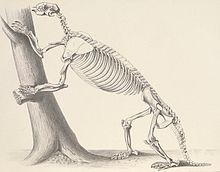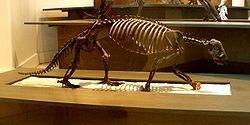fi
nimet breadcrumb-navigoinnissa


Hapalops és un gènere extint de peresós terrestre de l'Oligocè tardà que en allò que avui en dia és Sud-amèrica.
Tenint en compte que està emparentat amb el megateri, Hapalops era molt més petit, fent 1 metre de longitud. Com la majoria de peresosos terrestres es classifica com a peresós terrestre, però es creu que la mida més petita de Hapalops li permetia enfilar-se i adoptar comportaments d'escalada.[1] Tenia un cos robust, crani curt i extremitats allargades amb urpes grans i corbes. Quan aquest animal es desplaçava per terra probablement ho feia caminant sobre els nusos dels dits de les seves extremitats anteriors, com un goril·la. Hapalops tenia poques dents, cap incisiu, les mandíbules incloïen només quatre parells de dents.[2][3]
Hapalops representa un malson taxonòmic que necessita ser revisat, a aquest gènere se li han assignat unes 30 espècies diferents, moltes de les quals semblen ser sobrants.
Hapalops és un gènere extint de peresós terrestre de l'Oligocè tardà que en allò que avui en dia és Sud-amèrica.
Tenint en compte que està emparentat amb el megateri, Hapalops era molt més petit, fent 1 metre de longitud. Com la majoria de peresosos terrestres es classifica com a peresós terrestre, però es creu que la mida més petita de Hapalops li permetia enfilar-se i adoptar comportaments d'escalada. Tenia un cos robust, crani curt i extremitats allargades amb urpes grans i corbes. Quan aquest animal es desplaçava per terra probablement ho feia caminant sobre els nusos dels dits de les seves extremitats anteriors, com un goril·la. Hapalops tenia poques dents, cap incisiu, les mandíbules incloïen només quatre parells de dents.
Hapalops representa un malson taxonòmic que necessita ser revisat, a aquest gènere se li han assignat unes 30 espècies diferents, moltes de les quals semblen ser sobrants.

Hapalops is an extinct genus of ground sloth from the Early to Late Miocene of Brazil (Solimões Formation), Bolivia (Honda Group), Colombia (Honda Group),[1] and Argentina (Santa Cruz Formation) in South America.[2]
Hapalops was first described by notable Argentine paleontologist and zoologist Florentino Ameghino in 1887, with his description of H. rectangularis as the type species. It was erected based on the posterior part of a left dentary that had been collected from the Miocene aged deposits of Santa Cruz, Argentina, though Ameghino also described a second partial mandible from the same deposits as part of the species, making it a paratype. All of these of these fossils have been lost and their fragmentary status puts the validity of the genus as a whole in jeopardy.[3]
Sloths in this genus had a long, robust body with more than 19 thoracic vertebrae, a short skull, and long limbs with large, curved claws. They were small sloths, measuring about 1 metre (3.3 ft) in length. On the ground, they probably walked on the knuckles of the forelimbs, like a gorilla. Hapalops had very few teeth with no incisors; the mandible included only four pairs of teeth.[4]
In the Santa Cruz, Hapalops fed on vegetation in intertropical wooded savannahs. It shared its environment with both herbivorous and predatory marsupials, sheep-sized glyptodonts, armadillos, anteaters, toxodonts, typotheres, and litopterns, as well as modern reptiles such as iguanas and birds such as rheas, geese, and hawks. Giant phorusrachid "terror birds" lived in the region and may have been the top predators.[5] Like most extinct sloths it is categorized as a ground sloth, but it is believed that the smaller size of Hapalops allowed it to engage in some climbing behaviors.[6]
The genus is classified within the Megatherioidea, which includes the megalonychid and the nothrotheriid sloths. While it is generally represented as an outgroup to Nothrotheriidae and a genus of uncertain relationships, it shows most of the character states that diagnose Nothrotheriidae and may be a close relative. At least 26 species in this genus have been named from the same Santa Cruz formation, a biological impossibility largely based on assigning new species names to fossil fragments. The genus awaits revision.[7]
 Life restoration of Hapalops longiceps and Propalaehoplophorus australis
Life restoration of Hapalops longiceps and Propalaehoplophorus australis  Skeleton
Skeleton Hapalops is an extinct genus of ground sloth from the Early to Late Miocene of Brazil (Solimões Formation), Bolivia (Honda Group), Colombia (Honda Group), and Argentina (Santa Cruz Formation) in South America.
Hapalops es un género extinto de mamíferos folívoros de la familia Megatheriidae. Eran perezosos terrestres emparentados con el gigante Megatherium, pero mucho más pequeños, midiendo aproximadamente 1 m de longitud.
A pesar de estar clasificado como perezoso terrestre, Hapalops vivió probablemente en los árboles la mayor parte de su vida.[1] Tenía un cuerpo robusto, cráneo recortado y patas largas con garras grandes y curvadas. Cuando bajaba de los árboles al suelo, este animal probablemente caminaba sobre los nudillos de sus patas delanteras, como hacen los gorilas en la actualidad.
Hapalops vivió durante el Oligoceno Tardío, hace alrededor de 25 millones de años en Suramérica. No poseía incisivos entre los pocos dientes con los que contaba (la mandíbula estaba compuesta por solo cuatro pares de dientes).[2][3]
Hapalops es un género extinto de mamíferos folívoros de la familia Megatheriidae. Eran perezosos terrestres emparentados con el gigante Megatherium, pero mucho más pequeños, midiendo aproximadamente 1 m de longitud.
A pesar de estar clasificado como perezoso terrestre, Hapalops vivió probablemente en los árboles la mayor parte de su vida. Tenía un cuerpo robusto, cráneo recortado y patas largas con garras grandes y curvadas. Cuando bajaba de los árboles al suelo, este animal probablemente caminaba sobre los nudillos de sus patas delanteras, como hacen los gorilas en la actualidad.
Hapalops vivió durante el Oligoceno Tardío, hace alrededor de 25 millones de años en Suramérica. No poseía incisivos entre los pocos dientes con los que contaba (la mandíbula estaba compuesta por solo cuatro pares de dientes).
L'apalope (gen. Hapalops) è un mammifero estinto vissuto nel Miocene inferiore (circa 20 milioni di anni fa) in Sudamerica, imparentato alla lontana con gli odierni bradipi.
Le dimensioni di questo animale erano più grosse di quelle dei loro attuali “cugini”, dal momento che il corpo, abbastanza massiccio, poteva raggiungere una lunghezza di un metro e venti. L'apalope è uno dei più antichi bradipi terricoli; questi animali successivamente, nel Pliocene e soprattutto nel Pleistocene, raggiunsero dimensioni davvero gigantesche con generi come Megatherium e Mylodon. Hapalops, dal canto suo, doveva essere un animale fondamentalmente terrestre, ma in grado comunque di muoversi anche attraverso gli alberi. Le caratteristiche delle zampe già rispecchiano quelle delle forme successive: i forti unghioni ricurvi degli arti anteriori servivano con ogni probabilità ad avvicinare il cibo alla bocca, oltre a permettere una locomozione quadrupede efficiente camminando sulle nocche.
L'apalope (gen. Hapalops) è un mammifero estinto vissuto nel Miocene inferiore (circa 20 milioni di anni fa) in Sudamerica, imparentato alla lontana con gli odierni bradipi.
Hapalops is een geslacht van uitgestorven zoogdieren die voorkwamen in het Vroeg- tot Midden-Mioceen, zo'n 20 miljoen jaar geleden. Er zijn bijna twintig soorten in dit geslacht benoemd.
Reuzenluiaards waren in Zuid-Amerika talrijk. Hapalops was een geslacht van tandarme soorten die klein waren in vergelijking met hun latere verwanten. De lengte bedroeg ongeveer een meter. De dieren hadden een stevig lichaam met een korte kop, een lange staart, lange slanke voorpoten en nog langere, maar krachtige achterpoten met lange klauwen aan alle tenen. Dankzij deze klauwen liepen de dieren als Gorilla's op hun knokkels. De dieren hadden slechts vier of vijf paar kiezen in hun kaken.
De lichtgebouwde dieren zullen veel van hun tijd hangend aan hun geklauwde voeten in bomen hebben doorgebracht. Het voedsel bestond hoofdzakelijk uit sappige bladeren en fruit.
Fossielen werden gevonden in Brazilië, Bolivia en Patagonië.
Bronnen, noten en/of referentiesHapalops is een geslacht van uitgestorven zoogdieren die voorkwamen in het Vroeg- tot Midden-Mioceen, zo'n 20 miljoen jaar geleden. Er zijn bijna twintig soorten in dit geslacht benoemd.
Латинское название Hapalops Ameghino, 1887
Hapalops (лат.) — вымерший род наземных ленивцев из семейства Megatheriidae. Жил в Южной Америке в конце олигоцена.
Хотя этот род и в родстве с гигантскими мегатериями, его представители были намного мельче — длина тела около 1 метра. Они имели крепкое туловище, короткий череп и длинные конечности с большими изогнутыми когтями. Hapalops имели очень мало зубов. У них полностью отсутствовали резцы, а в нижней челюсти было всего четыре пары зубов[1].
По земле эти животные, вероятно, ходили на костяшках пальцев передних конечностей, как гориллы. Это наземные ленивцы, но считается, что небольшой размер позволял им взбираться на деревья[2].
Hapalops (лат.) — вымерший род наземных ленивцев из семейства Megatheriidae. Жил в Южной Америке в конце олигоцена.

ハパロプス (Hapalops) は、新生代古第三紀漸新世の南アメリカ大陸に生息していたオオナマケモノの一種である。